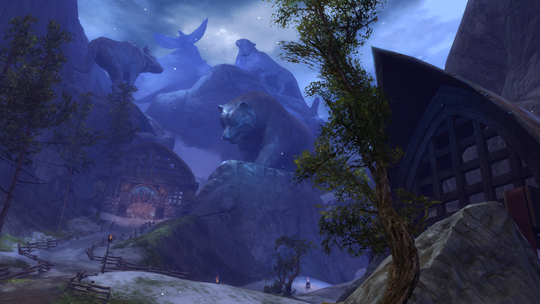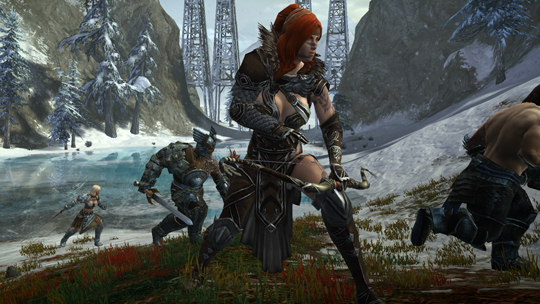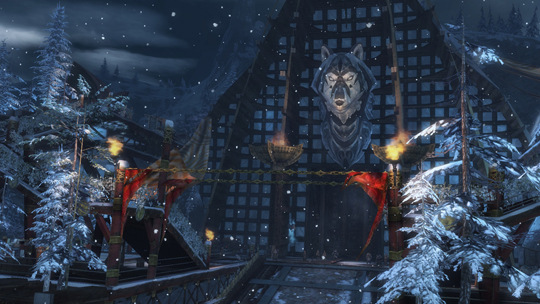
When Guild Wars was first released in 2005, it brought with it some revolutionary concepts and ideas to the MMO genre. No monthly subscription fees or mandatory micro-transactions, only a limited amount of skills to be used in combat as opposed to everything you had learned, a mostly instanced game world, and an emphasis on both PvP and an involving story. Many did not believe the game would last because of these variations from the norm, but it has gone on to be the second-most populated and successful title in the genre behind World of Warcraft. A lot of things will be different in Guild Wars 2 (mostly persistent world, a third axis, etc.), and I got to find out at PAX East whether or not those changes have improved or worsened the quality of the original’s winning formula.
The differences from not just the original, but the rest of the MMO pack started to show themselves right upon character creation. Although the actual appearance of my avatar couldn’t be edited, as ArenaNet isn’t ready to reveal those details just yet, I was asked to answer a series of questions that would define my character’s personality for his unique story. After choosing my profession, which was the Guardian, I was asked as a Norn whether I would conduct myself with charm, dignity, or ferocity, which of the four revered Spirits of the Wild I worship, what happened to me at the last moot, and more. These would not only shape how NPCs may react to me and how my character may act during certain dialogue sequences, but also possibly determine future quest lines. Right off the bat, these gave my character more individual depth than I’ve ever experienced in an MMO.
Guild Wars 2 continued to set itself apart right after that, as I was given a cutscene depicting my character’s introduction to the story that even deviates for a sequence or two depending on how I answered my earlier questions. They are illustrated beautifully by slightly-animated concept art combined with the occasional in-game models sprinkled in. Once the scenes ended, I was dropped right into the Norn race’s starter area. After finding an NPC that would continue my story, I saw the first special dialogue scene that is used for each character’s personal tale.
Instead of a full cutscene or a wall of text from the NPC, I was given a background featuring yet another wonderfully drawn art piece. This piece doesn’t just sit in the background, though, the camera instead scanned around the whole drawing to keep from a boring, stoic setting. Meanwhile, the foreground takes turns showing the model that is speaking their dialogue in full animation. Each character is also fully voiced, with text at the top of the screen if one feels the desire to read what’s being said. In story dialogue I encountered later in the demo, options were presented that would reflect the ways my character could respond. I could choose to play out the personality I chose in the beginning, or select options that would slowly change my attitude and how other characters reacted to me.
My avatar then set out to hunt for trophies that would allow me to take part in the end event that would propel me into the main game. I found a tracker who led me to a pack of minotaur so I could pluck one off for my own, I rustled a bush to scare out and slay a moa bird, and I laid some meat upon a trap to lure a skelk out for the kill. The combat is similar to that of the original, but with different twists. No longer can players simply double-click on an enemy to follow it into an auto attack. You will have to chase them down and use your primary skill. That’s right, the player’s basic attack is the first skill in their bar, not the left mouse button. Anyone who doesn’t want to continually press "1" on the keyboard, though, can easily hotkey the skill to the right mouse button for a more traditional feel.

Dodging and positioning is key in Guild Wars 2 combat. Moving from side to side will help you avoid attacks, while rolling will give you the distance needed for either a heal, ranged attack, or simple regroup. It works surprisingly well and is a great way to stay in the fight as long as possible while giving you the best chance of escaping trouble when things get ugly. Anyone who thinks it won’t be a necessary element will quickly find themselves on the ground fighting for their lives quite often.
As for the Guardian’s play style, it feels like an interesting mix of multiple Guild Wars classes. The smiting and protection of the Monk and the power and versatility of the Warrior are obvious, but there are also hints of the Paragon, Dervish, and Ritualist as well. In addition to the standard mace attack, I was able to use a skill that placed a large symbol on the ground and dealt damage to any foe within the vicinity. When I obtained a sword and exchanged that for the mace, a sword-specific attack that hit multiple enemies and extended its range with a blue aura became available. This showed that skill variety won’t just come with profession, but with the different and various weapons at each class’ disposal.
Last were the Guardian’s three virtues. Of the three, Justice was the most noticeable in multiple ways. Every five attacks, Justice will allow the Guardian to deal burning damage to an enemy, which can be seen visually on the foe. ArenaNet has also created a visual meter of blue flames above the left side of the skill bar, where the skill images for the virtues are positioned, that will build in intensity to show players how close they are to dealing their next righteous fire. Though they weren’t in the current build of the game that I played, I was informed by multiple ArenaNet developers that the same kind of visual reminder will be applied for the other two virtues: Courage and Resolve. Courage allows you to block an attack every 30 seconds. If the player pays close enough attention to the action itself, his or her shield will have another shield of blue energy placed over it to show Courage is active. Resolve currently only shows itself through the health you slowly regenerate.
When the hunt was finished, I spoke to an NPC that guided me in the direction of the first of the game’s events for Norn characters, known as "The Great Hunt." I got there before the other players in my area, so to tide me over while waiting, a bar fight broke out next to base of the mountain we needed to climb. It was then up to me to either keep waiting and ignore the drunken loons, or kill time beating them up via melee combat to put the brawl to a halt. It was a nice way to show minor events that can erupt in inhabited areas and what could be done to keep people busy if waiting on other players for whatever reason.
The boss awaiting at the top of the small mountain was a massive ice worm, which was lured out after we killed its hatchlings. The beast was titanic and made me really feel like a hero, not some peon who is only good for killing rats. After a relentless assault on the monster that swept at us and summoned hatchlings to distract us, the other players, NPCs, and myself finally slayed our foe.

Once the world opened up again, and knowing the Norn home city of Hoelbrak was nearby, I turned around and headed straight up a hill adorned with massive statues of the four Spirits of the Wild carved out of the mountain and into the Norn settlement. It’s a massive area filled with NPCs of various races, though mostly Norn, and enormous halls. Statues of the famous Norn hero Jora, who was a main character of Guild Wars: Eye of the North, were displayed in public gathering areas. Trying to interact with the populace, a pair of Charr travelers told me to get lost while a Sylvari interacted with me in a dialogue very different from those in the main storyline.
Through normal conversational options, I discovered that this member of the humanoid plant race wanted to visit the Dragonbrand, a ruthless area ruled by crystallized minions of the elder dragon Kralkatorrik, and wondered why the Asura working the fast-travel gate in the city wouldn’t assist in her suicide. She knew the area was dangerous, but lacked experience of what danger on that magnitude was. She couldn’t fathom the feelings that came with the information, a true display of a key trait of the Sylvari: Having vast knowledge but extreme naivety regarding said knowledge. It was an amazing, though short, interaction that showed me insight into one of the game’s four races.
A discovery made when exploring the city was another change from Guild Wars to its sequel. That is how skills are acquired. Players will still need to go to trainers to obtain them, but instead of earning skill points as rewards for quests and level-ups, they are now purchased with in-game currency. Each was a fair amount of copper, and I’m not sure if better skills will cost more or less later in the game. They are unlocked for purchase progressively as players reach certain levels. It’s an interesting change, but also something that truly can’t yet be judged as a good or bad thing until release.
With time running out on my session I decided to leave the city and head for more gameplay. What I found was one more interesting twist that I haven’t normally seen in other MMOs and haven’t seen at all in the original game. Upon visiting the shrine of Raven to check out the dynamic event going on there, I discovered something else entirely. Mistakenly interacting with a Raven shrine, I was given a new quest and a riddle. Raven is known for his wisdom, so for his shrine’s unique quest, players must answer a series of riddles to test their own wisdom. Never before has my brain been picked and tested in this manner to earn experience points and items. It was a great twist and genius way to change up the flow of the game. Upon completing the quest and soon after helping with the removal of skelk trying to steal raven eggs, my demo session ended.
It was abundantly clear that Guild Wars 2 has become a different animal from its predecessor, but not so much that it is unrecognizable. The skill-based combat, lore, and environments all gave it that Guild Wars feel that fans have come to know and love. At the same time, the persistent world, dynamic events, upgraded dodging, new classes, new races, and other changes keep the game feeling new and refreshing. While a few of the changes may be a bit strange at first, they seem to fit perfectly after one takes the time to get used to them. The game is shaping up to be a real winner, so here’s hoping that Guild Wars 2 does just that when it releases, in ArenaNet’s words, "when it’s ready."


















One Comment on "Guild Wars 2 Hands-On Preview"